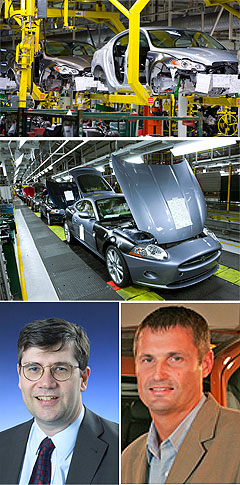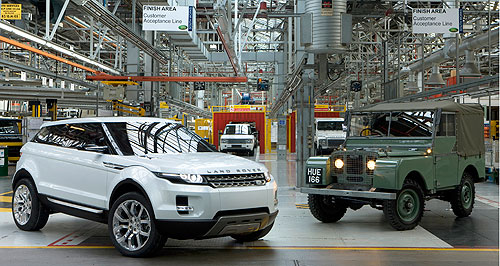Make / Model Search
News - Land RoverGreen shoots for Jaguar Land RoverGoing green: Jaguar Land Rover digs deep to catch up in the race for environmental competitiveness. JLR commits $1.47 billion for ‘green’ push in expanded range25 Sep 2009 JAGUAR Land Rover (JLR) has promised an expanded range and new environmental technologies in a “greener and sustainable” business plan to see the struggling company through the market recovery and position it “to grow and prosper in the future”. In an announcement in the UK coinciding with confirmation that Land Rover would build its smallest and most efficient Range Rover – the LRX – JLR said it aimed to “increase its global competitiveness significantly, drive growth and sustained profitability, and respond to the challenges of climate change”. Jaguar Land Rover CEO David Smith said the company had committed £800 million ($A1.47 billion) to environmental technologies in reforms to be delivered through streamlined and competitive costs and a new manufacturing strategy. “This is a plan that recognises the impact the economic collapse has had on our business, and at the same time the opportunities that lie ahead for these two great brands,” he said. “We are confident that a new, more efficient and competitive structure combined with future investment will unlock the true potential of this business.” JLR says its global sales are down 25 to 30 per cent in line with the industry and only 60 per cent of manufacturing capacity is being used. Combined with the world credit crisis, this had “exposed fundamental weaknesses in the structure of the business”.  From top: XF and XK in production, Jaguar Land Rover CEO David Smith (left) and Land Rover managing director Phil Popham. From top: XF and XK in production, Jaguar Land Rover CEO David Smith (left) and Land Rover managing director Phil Popham.It admits that aggressive spending reductions and cost cutting over the past 12 months – when production was reduced by more than 100,000 units, employment reduced by 2500, wages frozen and bonuses cancelled – “was not enough to offset the full magnitude of the downturn and the company swung from profit in 2007 to significant losses over the past 12 months”. “This was not a sustainable situation,” the company said. “Actions taken have started to reverse the trend quarter over quarter and we now have to take the company to the next level of competitiveness. “The new plan identifies global competitive benchmarks. These recognise that Jaguar Land Rover has to match if not beat the levels of cost and efficiency achieved by competitors that manufacture in multiple locations around the world.” According to the historic British maker, both brands' portfolios will expand through a series of new segment entries that build on Jaguar and Land Rover’s design, performance and technology excellence. “A new generation of lightweight sedans, sports cars and premium SUVs, with hybrids and electrification technology, will significantly reduce fuel consumption and CO2. Some £800 million has been dedicated to environmental innovation, which will in part be supported by European Investment Bank funds. Finally, there will be additional derivatives and powertrain variants from core model lines. “As the company reduces engineering complexity for its new product range, West Midlands manufacturing will transfer from two plants to one by the middle of the next decade, improving efficiency and cost. “Further cost reductions include pension restructuring, lower employment costs for new hires and a focus on IT and business simplification. Volume growth, especially in emerging markets, combined with low-cost country sourcing will also reduce variable cost. The entire package of measures does not envisage any compulsory redundancies.” The new small Range Rover LRX concept was shown at Detroit with a 2.0-litre turbo-diesel hybrid electric powertrain that Land Rover said at the time would use about 30 per cent less fuel than other 4WDs of comparable size. A similar drivetrain is expected to be at least an (expensive) option within the compact Land Rover’s model range, with an electrically driven rear axle likely to work in combination with the engine-driven front wheels. Land Rover managing director Phil Popham told GoAuto last week that hybrid technology would be forthcoming from Land Rover, and “not just for LRX”. “Hybrid is one of the technologies on our radar. Our approach at the moment and what we delivered with 10MY (Discovery and Range Rover Sport and Vogue) is illustrating that we’re focussing on getting the base car right. “Hybrid will be one technology that improves the fuel efficiency and CO2 emissions, but if it’s going to sit on the top-end or be a very small percentage of sales you’ve got to actually work on everything else. “We don’t believe it’s a silver bullet to sustainability, so beyond new technologies we’ve got to start getting weight out of our vehicles. “Obviously if the LRX concept car comes into production it will be smaller and lighter and have appropriate powertrains to deliver fuel efficiency. “So we are looking at hybrids. We will have hybrids in future – not just on our small cars but on our larger cars, but that will serve a relatively small percentage.” Asked if Land Rover’s introduction of hybrid power would take a ‘top-down’ approach with hybrid power, Mr Popham said: “That’s a logical assessment. What we’re seeing across the industry is that hybrid is the buzzword at the moment for consumers. “We’re doing a lot of research and their expectations are that the manufacturers will sort this thing called sustainability. “They want better fuel efficiency, they want lower emissions, but actually they’re pretty unwilling to pay for it. There are very few people willing to pay to be green and hybrid technology’s incredibly expensive. “So it may well be that you can get a higher proportion of hybrids in larger, more expensive cars and you can actually swallow some of that cost. “The one issue that the industry is grappling with is ‘pick one more feature’. They (the customers) want electric everything – more in-car entertainment, more things to play with in the car. All those things add weight. “Safety legislation is the only thing that is actually keeping pace with emissions legislation. Generally the safer you make the car, the heavier you make it. So you’ve got to get a balance of weight and strength. “You’ve got to look at everything from the seat to the wheel, plastic composites, every single component you put in has a trade-off between durability, cost and weight, so that’s an added consideration we didn’t have 10 years ago.”  Read more25th of September 2009  Official: Land Rover signs off on LRXSmallest, lightest, most efficient model confirmed for production by Land Rover21st of September 2009  New Range Rover baby nearFirst compact Rangie is little more than 12 months away16th of September 2009  Jaguar keeps new XJ opening price below $200,000Jaguar XJ to undercut BMW and Benz limos when it arrives early in 20107th of August 2009  Land Rover launches the frugal Freelander TD4_eLeanest, greenest Land Rover arrives in Australia as the Freelander 2 TD4_e |
Click to shareLand Rover articlesResearch Land Rover Motor industry news |











Facebook Twitter Instagram